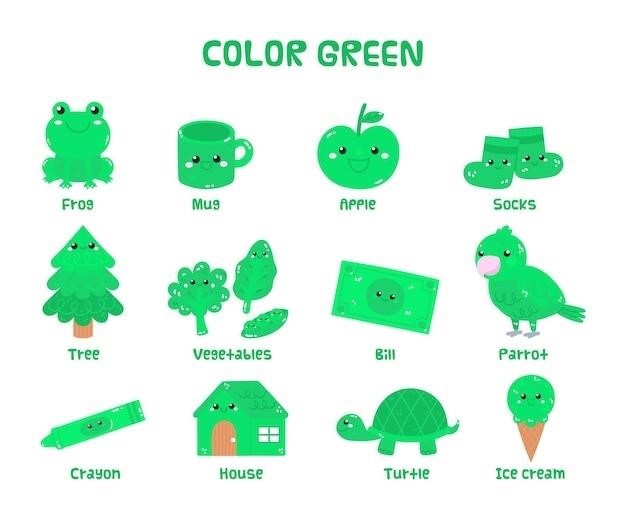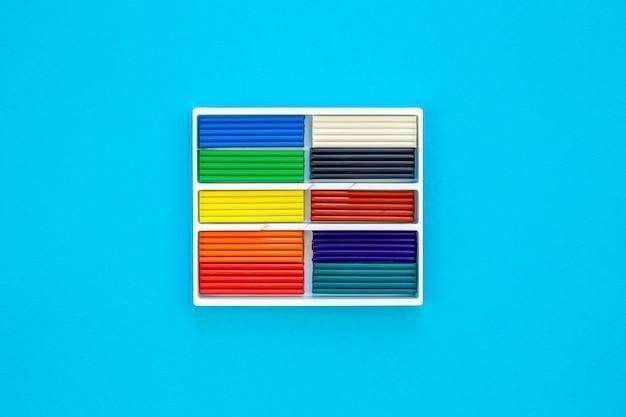Color Matching Guide⁚ A Comprehensive Overview
This guide explores the art of color matching, providing a comprehensive overview of the principles and techniques that can help you create harmonious and stylish outfits. We will delve into the importance of understanding your skin tone, the fundamentals of color theory, and how to effectively utilize different color schemes to enhance your personal style.
Understanding Skin Tones
Your skin tone is a fundamental factor in color matching. It refers to the underlying pigment of your skin, which can be categorized into three main groups⁚ warm, cool, and neutral. Understanding your skin tone is crucial because it helps you determine which colors will complement your natural coloring and make you look your best.
Warm skin tones have a yellowish or golden undertone. People with warm skin tones often have brown, olive, or peachy complexions. They look best in warm colors like reds, oranges, yellows, and browns.
Cool skin tones, on the other hand, have a pinkish or bluish undertone. They tend to have fair, pale, or rosy complexions. People with cool skin tones are generally best suited for cool colors like blues, greens, purples, and pinks.
Neutral skin tones fall somewhere in between warm and cool. They have a balanced undertone that can be difficult to categorize. Neutral skin tones can wear a wider range of colors, but they may find that certain colors look better on them than others.
Once you’ve identified your skin tone, you can start to explore the world of color matching and discover the colors that will make you look and feel your best.
Identifying Your Skin Tone
Determining your skin tone might seem daunting, but it’s a simple process once you know what to look for. Here are some effective methods to identify your skin tone⁚
Check your veins⁚ Look at the veins on the inside of your wrist. If they appear blue or purple, you likely have a cool skin tone. If they appear green, you probably have a warm skin tone. If you can’t tell, you might have a neutral skin tone.
Observe your jewelry⁚ Pay attention to the jewelry that looks best on you. If you find that silver or white gold flatters you more than gold, you likely have a cool skin tone. If gold jewelry makes you glow, you probably have a warm skin tone. If you can wear both without any noticeable difference, you might have a neutral skin tone.
Test with fabric⁚ Hold a white piece of fabric against your face. If your skin appears pink or rosy, you have a cool skin tone. If it looks yellowish or golden, you have a warm skin tone. If it looks neither pink nor yellow, you might have a neutral skin tone.
Sun reaction⁚ Consider how your skin reacts to the sun. If you tend to tan easily and rarely burn, you likely have a warm skin tone. If you burn easily and rarely tan, you probably have a cool skin tone. If you tan and burn with equal ease, you might have a neutral skin tone.

Remember, these are just general guidelines. It’s always best to experiment with different colors and see what works best for you.
The Color Wheel and Color Theory
Understanding the color wheel and basic color theory is crucial for effective color matching. The color wheel is a circular diagram that arranges colors based on their relationships. It’s a visual tool that helps us understand how colors interact with each other.
Primary Colors⁚ Red, yellow, and blue are considered primary colors. They cannot be created by mixing other colors.
Secondary Colors⁚ Orange, green, and violet are secondary colors. They are created by mixing two primary colors. For example, orange is created by mixing red and yellow.
Tertiary Colors⁚ Tertiary colors are created by mixing a primary color with a neighboring secondary color. Examples include red-orange, yellow-green, and blue-violet.
Complementary Colors⁚ Complementary colors are opposite each other on the color wheel. When placed next to each other, they create high contrast and visually enhance each other. Examples include red and green, blue and orange, and yellow and purple.
Analogous Colors⁚ Analogous colors are located next to each other on the color wheel. They create a harmonious and subtle effect, often used in fashion and interior design. Examples include blue, blue-green, and green.
Monochromatic Color Schemes⁚ Monochromatic color schemes use different shades, tints, and tones of the same color. This creates a sophisticated and cohesive look.
Triadic Color Schemes⁚ Triadic color schemes use three colors that are evenly spaced on the color wheel. They create a balanced and vibrant look.
By understanding these color relationships, you can create visually appealing and harmonious color combinations for your outfits;
Complementary Colors
Complementary colors are pairs that sit directly opposite each other on the color wheel. They create a high-contrast effect that makes each color appear brighter and more vibrant when placed next to each other. This dynamic pairing is often used in fashion to add visual interest and make an outfit pop.
Examples of complementary color pairs include⁚
- Red and Green⁚ This classic combination is bold and eye-catching. Think of a red dress paired with emerald green accessories or a green top with a red scarf.
- Blue and Orange⁚ This pair creates a vibrant and energetic look. A blue shirt with an orange belt or an orange skirt with a blue cardigan are great examples.
- Yellow and Purple⁚ This combination is both cheerful and sophisticated. A yellow blouse paired with a purple skirt or a purple dress with a yellow belt can create a striking outfit.
While complementary colors create a strong contrast, it’s essential to use them strategically. Too much of one color can overwhelm the outfit, so consider using one color as the dominant hue and the other as an accent. For instance, you could wear a red dress with a green scarf and a pair of green earrings, or a blue shirt with an orange belt and orange shoes. You can also soften the contrast by incorporating neutral colors like black, white, or gray.
By understanding how to use complementary colors effectively, you can create eye-catching outfits that are both stylish and balanced.
Analogous Colors
Analogous colors are found next to each other on the color wheel, creating a harmonious and visually pleasing effect. They share a common hue and often blend seamlessly, creating a sense of unity and sophistication. Analogous color schemes are versatile and can be used to create a range of looks, from subtle and calming to vibrant and energetic.
Here are some examples of analogous color schemes⁚
- Blue, Blue-Green, Green⁚ This cool-toned scheme evokes a sense of tranquility and freshness, perfect for summer outfits or relaxed everyday looks.
- Yellow, Yellow-Orange, Orange⁚ This warm-toned scheme is vibrant and energetic, ideal for creating a bold statement or adding a touch of sunshine to your wardrobe.
- Red, Red-Violet, Violet⁚ This scheme is rich and dramatic, making a statement with its deep hues. It’s perfect for evening wear or creating a sophisticated look.
When using analogous colors, consider choosing a dominant color and using the other two as accents. For example, you could wear a blue shirt with a blue-green scarf and green earrings, or a yellow dress with a yellow-orange belt and orange sandals. To create a more balanced look, you can also incorporate a neutral color like black, white, or gray.
Analogous colors offer a harmonious and versatile way to create visually appealing outfits. Experiment with different combinations to find your favorite looks and express your unique style.
Monochromatic Color Schemes
Monochromatic color schemes utilize various shades, tints, and tones of a single color. This creates a sense of unity and sophistication, making it a timeless and elegant choice for any occasion. The absence of contrasting hues allows for a cohesive and harmonious look, emphasizing the chosen color’s depth and complexity.
Here’s how to effectively utilize monochromatic color schemes⁚
- Start with a Dominant Hue⁚ Select a single color as your foundation, whether it’s a bold red, a calming blue, or a sophisticated gray. This hue will set the tone for your entire outfit.
- Introduce Variation⁚ Play with different shades, tints, and tones of your chosen color. Lighter shades can be used for accents, while darker shades can be incorporated for grounding and structure.
- Incorporate Neutrals⁚ While a monochromatic scheme focuses on one color, incorporating neutral tones like black, white, or cream can add balance and depth to the overall look.
- Consider Texture⁚ To prevent monotony, experiment with different textures within your monochromatic palette. For example, combine a smooth silk top with a textured wool skirt or a soft knit sweater with a leather jacket.
Monochromatic color schemes are effortlessly stylish and create a sense of refinement. Whether you’re aiming for a minimalist aesthetic or a dramatic statement, using varying shades of a single color offers a timeless and elegant approach to color matching.
Triadic Color Schemes
Triadic color schemes are based on three colors that are equidistant on the color wheel, creating a vibrant and dynamic visual impact. This scheme offers a balanced and harmonious approach, ensuring that each color stands out while complementing the others. Triadic color schemes are often used for bold and eye-catching ensembles, adding a touch of energy and vibrancy to any outfit.
Here’s how to create effective triadic color combinations⁚
- Choose Three Colors⁚ Select three colors that are evenly spaced on the color wheel. For example, red, yellow, and blue, or green, orange, and purple.
- Vary Saturation⁚ Experiment with different levels of saturation for each color. This adds depth and dimension to the scheme, preventing it from appearing overly uniform.
- Balance the Colors⁚ Ensure that no single color dominates the outfit. Distribute the three colors strategically, using one as the main focus and the other two as accents.
- Incorporate Neutrals⁚ Adding neutral tones like black, white, or gray can help to ground the triadic scheme and create a more balanced and cohesive look.
Triadic color schemes are versatile and can be adapted to suit different styles and occasions. They offer a bold and eye-catching approach to color matching, adding a touch of vibrancy and excitement to your wardrobe.
Creating a Color Palette for Your Wardrobe
Developing a personal color palette is a fundamental step in mastering the art of color matching. It’s a curated selection of colors that flatter your skin tone, enhance your personal style, and create a cohesive and harmonious wardrobe. A well-defined color palette provides a framework for choosing outfits, ensuring that every piece complements the others and contributes to a stylish and confident overall look.
Here’s a step-by-step guide to creating your personal color palette⁚
- Identify Your Skin Tone⁚ Determine whether you have warm, cool, or neutral undertones. This is essential for choosing colors that will enhance your natural complexion.
- Experiment with Colors⁚ Try on different colors and observe how they interact with your skin tone. Pay attention to how colors make you feel and how they complement your natural features.
- Consider Your Style⁚ Choose colors that reflect your personal style preferences. Do you prefer bold and bright hues or soft and muted tones? Are you drawn to classic neutrals or vibrant accents?
- Create a Color Board⁚ Gather fabric swatches, magazine clippings, or online inspiration that showcases the colors you love. This visual representation will help you visualize how the colors work together and guide your wardrobe choices.
- Refine and Adjust⁚ As your style evolves, you may want to refine your color palette. Remove colors that no longer resonate with you and add new ones that reflect your current preferences.
A well-defined color palette empowers you to create stylish and cohesive outfits, ensuring that every piece in your wardrobe complements your personal style and flatters your unique beauty.

0 comments on “colour match guide”Add yours →